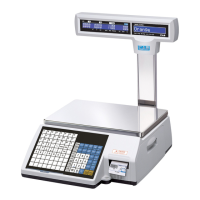
Do you have a question about the CAS CL5000 Series and is the answer not in the manual?
| Power Source | AC adapter |
|---|---|
| Auto Calibration | Yes |
| Tare Function | Yes |
| Unit Conversion | Yes |
| Interfaces | RS-232 |
| Operating Temperature | -10°C to 40°C |
| Weighing Units | kg, g |
| Approval | NTEP, OIML |
Safety instructions for installing the scale to ensure proper usage and prevent hazards.
Welcome message and overview of the CAS CL5000 scale's features and benefits.
Technical details including capacity, tare, resolution, platter size, keys, display, and power.
Identifies the different scale types (Standard, Pole, Hanging) and their basic configurations.
Step-by-step guide on how to install the scale's tray and mounting components.
Explanation of the various symbols used on the scale's display and indicators.
Details the purpose and usage of each key on the scale's keypad for operation and programming.
Instructions and specifications for correctly installing the label roll into the printer.
Guide to setting up PLU (Price Look-Up) items, including types, names, and various parameters.
Configuration of PLU data, including departments, groups, tax rates, and sales messages.
Detailed programming for PLU data, covering ingredients, nutrition facts, and traceability.
Setting up various discount types, including unit price, total price, and fixed price discounts.
Configuring discounts that apply globally across PLUs, including priority settings.
How to program and assign frequently used PLUs to speed keys for quick access.
Setting up traceability information, such as country of origin and slaughterhouse details, for PLUs.
Managing country data used for traceability and other location-specific settings.
Entering and managing slaughterhouse data, linked to traceability information.
Entering and managing cutting hall data, relevant for traceability information.
Setting up store information, including names, telephone numbers, and customer data.
Configuring global settings like label formats and barcode options for the scale.
Setting up printer functions, label items, markdown, and hardware configurations.
Main section for configuring scale operations, including sale modes, date/time, and user security.
Accessing and generating various sales reports (X1, X2, Z1, Z2) for data analysis.
Explains basic scale operations like setting zero, tare, calling PLUs, and overriding prices.
How to use the ZERO key to correct for weight deviations and set the initial zero.
Procedures for entering tare weights manually or using the weighed tare entry method.
Methods for retrieving a PLU using numeric keys or preset keys for sales transactions.
Using the OVERRIDE key to temporarily change the pricing of PLUs for specific sales.
Demonstrates sales operations for weighed items, including how to call up PLUs and print labels.
Details on setting up and applying different types of discounts based on PLU type and sales conditions.
Process for performing add-up transactions, allowing multiple items to be summed before final sale.
Explains the different clerk modes (No Clerk, Standard, Floating) for managing sales operations.
Procedure for undoing transactions in add-up or floating clerk operations using the VOID key.
Steps for handling customer payments, including different payment types and calculating change.
How to process returns for erroneous sales transactions using the RETURN key.
Using the Prepack mode for automatic label printing, increasing efficiency in back-room operations.
Functionality of the X key for printing multiple transactions or labels for the same PLU.
Instructions on how to modify the sell-by date and time for PLU items.
Procedure for changing the origin information associated with a PLU.
Steps to change a PLU's type (e.g., from By-Weight to By-Count) and the implications.
Using fixed price or percentage discount keys for direct price adjustments on PLUs.
Explains functions like Referenced, Coupled, and Linked PLUs for product relationships.
Settings for controlling sales operations, including fixed weight and prepack without reports.
Information on fixed and user-defined label formats, including specifications and layout options.
Visual examples of different label formats used for product information.
Details on various fields available for item and total labels, with their corresponding IDs.
A table mapping ASCII characters to their corresponding numerical codes for special input.